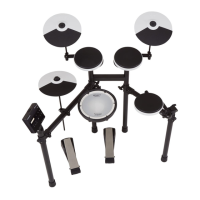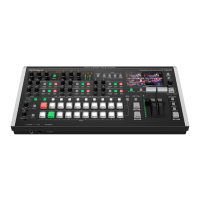10
KIT EDIT
OVERHEAD
Parameter Value Explanation
TEMPLATE
CLEAR, WARM, DRY, MILD, BRIGHT,
OTHER1–4
When you edit this parameter, all of the overhead settings (except for Level) and each pad's input
lter selection and send amount will change to the optimal settings.
To quickly obtain the sound you want, select the desired template and then edit the settings.
* Depending on the settings of each parameter, the template name might not match the eect.
Also, if the default settings of the template do not match the current values, an “*” is shown for the
template setting.
If you attempt to change the template when the “*” is shown, a message indicates that the current
values will be discarded in order to apply the values of the template. If you want to discard the
current values and apply the values of the template, choose “OK” and press the [ENTER] button.
Level
-INF–+12.0dB Volume of overhead
Mic Type *1
TYPE1–4 Type of mic
Mic Width *1
0–4 Distance between mics
[F1] button (OFF, OVHEAD ON)
OFF, OVHEAD ON Turns the overhead eect on/o.
*1: This can also be edited from the MIC SETTING items.
SEND
OVERHEAD SEND screen
OVERHEAD FILTER ASSIGN screen
OVERHEAD INPUT FILTER SETTING screen
Parameter Value Explanation
[F2] button (SEND tab)
OVERHEAD SEND
-INF–+6.0dB Depth of overhead for each pad
[F5] button (H & R)
H&R OFF, H&R ON Species whether head and rim of instruments are selected as a set (ON) or independently (OFF).
[F3] button (ASSIGN tab)
OVERHEAD FILTER ASSIGN
BYPASS, 1–4
Overhead input lter selection for each pad
BYPASS The input lter is not used; the sound is sent directly to the overheads.
1–4 The sound is sent to the specied input lter.
[F5] button (H & R)
H&R OFF, H&R ON Species whether head and rim of instruments are selected as a set (ON) or independently (OFF).
[F4] button (FILTER tab)
Type
THRU, LO CUT, HI CUT, LO SHELV, HI
SHELV, PEAKING
Overhead input lter type
The sound sent to the overheads can be passed through a lter. You can choose from one through
four. By using a lter, you can input the kick, snare, toms, and cymbals into the overhead mics with
the low-frequency and high-frequency regions adjusted individually for each instrument.
THRU Sends the input sound directly to the overheads.
LO CUT
Cuts the frequency region below the cuto frequency and sends the sound to
the overheads.
HI CUT
Cuts the frequency region above the cuto frequency and sends the sound to
the overheads.
LO SHELV
Boosts or attenuates the frequency region below the cuto frequency and
sends the sound to the overheads.
HI SHELV
Boosts or attenuates the frequency region above the cuto frequency and
sends the sound to the overheads.
PEAKING
Boosts or attenuates the region centered on the cuto frequency and sends
the sound to the overheads.
Q *1
0.5–8.0
Width of the frequency range
A higher Q narrows the aected area.
Freq *2
20Hz–16kHz Center frequency
Gain *3
-40.0–15.0dB Amount of boost/cut
*1: This can be set only when Type is LO CUT, HI CUT, or PEAKING.
*2: This cannot be set when Type is THRU.
*3: This can be set only when Type is LO SHELV, HI SHELV, or PEAKING.

